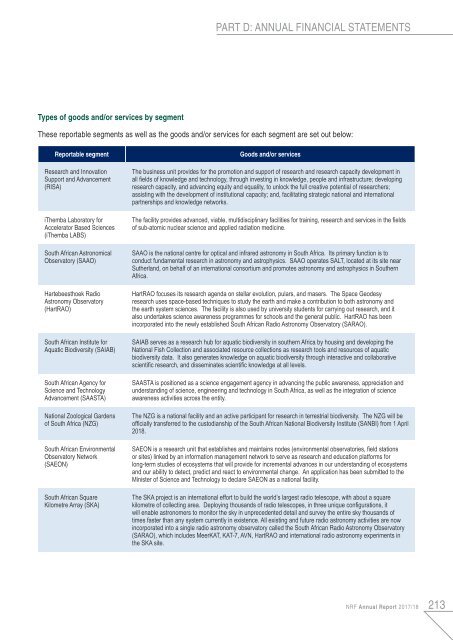NRF Annual Report 2018
You also want an ePaper? Increase the reach of your titles
YUMPU automatically turns print PDFs into web optimized ePapers that Google loves.
PART D: ANNUAL FINANCIAL STATEMENTS<br />
Types of goods and/or services by segment<br />
These reportable segments as well as the goods and/or services for each segment are set out below:<br />
<strong>Report</strong>able segment<br />
Research and Innovation<br />
Support and Advancement<br />
(RISA)<br />
iThemba Laboratory for<br />
Accelerator Based Sciences<br />
(iThemba LABS)<br />
South African Astronomical<br />
Observatory (SAAO)<br />
Hartebeesthoek Radio<br />
Astronomy Observatory<br />
(HartRAO)<br />
South African Institute for<br />
Aquatic Biodiversity (SAIAB)<br />
South African Agency for<br />
Science and Technology<br />
Advancement (SAASTA)<br />
National Zoological Gardens<br />
of South Africa (NZG)<br />
South African Environmental<br />
Observatory Network<br />
(SAEON)<br />
South African Square<br />
Kilometre Array (SKA)<br />
Goods and/or services<br />
The business unit provides for the promotion and support of research and research capacity development in<br />
all fields of knowledge and technology, through investing in knowledge, people and infrastructure; developing<br />
research capacity, and advancing equity and equality, to unlock the full creative potential of researchers;<br />
assisting with the development of institutional capacity; and, facilitating strategic national and international<br />
partnerships and knowledge networks.<br />
The facility provides advanced, viable, multidisciplinary facilities for training, research and services in the fields<br />
of sub-atomic nuclear science and applied radiation medicine.<br />
SAAO is the national centre for optical and infrared astronomy in South Africa. Its primary function is to<br />
conduct fundamental research in astronomy and astrophysics. SAAO operates SALT, located at its site near<br />
Sutherland, on behalf of an international consortium and promotes astronomy and astrophysics in Southern<br />
Africa.<br />
HartRAO focuses its research agenda on stellar evolution, pulars, and masers. The Space Geodesy<br />
research uses space-based techniques to study the earth and make a contribution to both astronomy and<br />
the earth system sciences. The facility is also used by university students for carrying out research, and it<br />
also undertakes science awareness programmes for schools and the general public. HartRAO has been<br />
incorporated into the newly established South African Radio Astronomy Observatory (SARAO).<br />
SAIAB serves as a research hub for aquatic biodiversity in southern Africa by housing and developing the<br />
National Fish Collection and associated resource collections as research tools and resources of aquatic<br />
biodiversity data. It also generates knowledge on aquatic biodiversity through interactive and collaborative<br />
scientific research, and disseminates scientific knowledge at all levels.<br />
SAASTA is positioned as a science engagement agency in advancing the public awareness, appreciation and<br />
understanding of science, engineering and technology in South Africa, as well as the integration of science<br />
awareness activities across the entity.<br />
The NZG is a national facility and an active participant for research in terrestrial biodiversity. The NZG will be<br />
officially transferred to the custodianship of the South African National Biodiversity Institute (SANBI) from 1 April<br />
<strong>2018</strong>.<br />
SAEON is a research unit that establishes and maintains nodes (environmental observatories, field stations<br />
or sites) linked by an information management network to serve as research and education platforms for<br />
long-term studies of ecosystems that will provide for incremental advances in our understanding of ecosystems<br />
and our ability to detect, predict and react to environmental change. An application has been submitted to the<br />
Minister of Science and Technology to declare SAEON as a national facility.<br />
The SKA project is an international effort to build the world’s largest radio telescope, with about a square<br />
kilometre of collecting area. Deploying thousands of radio telescopes, in three unique configurations, it<br />
will enable astronomers to monitor the sky in unprecedented detail and survey the entire sky thousands of<br />
times faster than any system currently in existence. All existing and future radio astronomy activities are now<br />
incorporated into a single radio astronomy observatory called the South African Radio Astronomy Observatory<br />
(SARAO), which includes MeerKAT, KAT-7, AVN, HartRAO and international radio astronomy experiments in<br />
the SKA site.<br />
<strong>NRF</strong> <strong>Annual</strong> <strong>Report</strong> 2017/18 213


